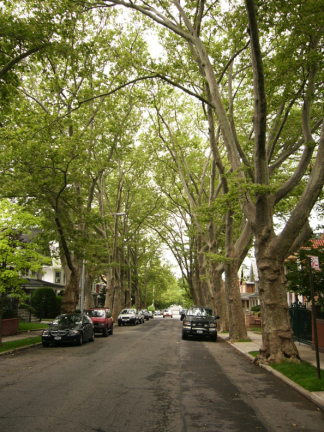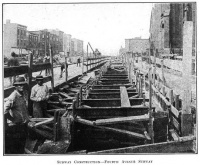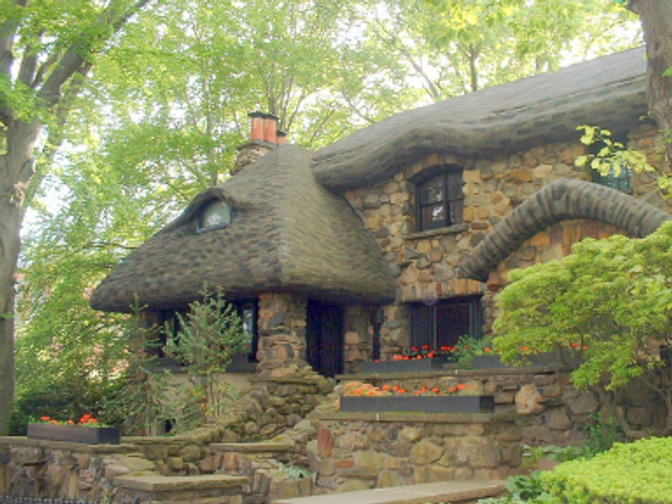From The Peopling of New York City
Me
Hi,I'm Sheri Soltan. I am currently attending Brooklyn Macaulay Honors College and I am majoring in Mass Media/Television and Radio. One of my main goals in life is to work on dry humored and pretty quirky television shows such as The Office or My Name Is Earl. I try to keep everything light and laid back so everyone's happy..most of the time.
Proposal

In New York City, the amount of interesting blocks that seem to have a story are countless. Choosing just one small area in an ocean of fascinating locations was no easy task. I have chosen a block close to where I live because I believe that what I learn about it will possibly be more meaningful to me and it will strike more of an appreciation for where I live.

Although Bay Ridge is a beautiful and quiet place, I can hear stories screaming and begging to be told from every corner. The block of this amazing neighborhood that I decided to focus on is 82nd Street and Narrows Avenue. On this block, you can find many beautifully built homes with intricate architecture. These sites make this block a perfect place for a peaceful walk by the ocean on a sunny day. Most of this block's inhabitants are rather wealthy and usually keep to themselves. Many of the families currently living there come from a long line of Shore Road dwellers and some of them have old postcards or photographs that show this area in a totally different light and time period, so I hope to get my hands on some of these gems.
There is one home on this block that strikes the most attention from passersby, however. It is locally known as the Gingerbread House because of its very similar appearance to the famous house in the story "Hansel and Gretel". I hope to find some interesting information on this house, such as the names and stories of the previous owners, why is was built, the architect that designed this home and when it was built. Such a beautiful piece of art should definitely hold some interesting stories. I'm certain that I'll have a new found appreciation for my neighborhood at the end of this experience.
Gingerbread House


Fourth Avenue Subway Construction
This rather odd-looking home has been called the “Gingerbread House” since I first moved to Bay Ridge. Not quite as curious as the house of the same name in “Hansel and Gretel” nor as delicious as the house-shaped cookies that we can usually find on holiday tables, but it nonetheless is a sight to be reckoned with. This house on 83rd Street and Narrows Road is across the street from Fort Hamilton High School, which is why I spent more time looking out of the window instead of at the blackboard in math class. It is an example of the Arts and Crafts School of Architecture, a fanciful school of design started by Oscar Wilde and others. The house was built in 1916-17 by J. Sarsfield Kennedy and was quickly referred to as the “Gingerbread House” even though it’s more properly referred to as the Howard E. and Jessie Jones House; after its original owners.[1]
Since the Fourth Avenue subway line was built in 1915, many mansions were destroyed and replaced by apartment buildings. A few ,including Fontbonne Hall Academy at 9901 Shore Road-now a private girl's school, still remain on the crest of the Ridge. In the early 1900s, Fontbonne was the vacation home of railroad tycoon "Diamond" Jim Brady. The house is rumored to have doubled as a speakeasy and a casino during Prohibition after Brady died, according to the Brooklyn Historical Society's Bay Ridge/Ft. Hamilton Neighborhood History Guide. The gingerbread house shows off its unique style of yore, with its Black Forest Art Nouveau architecture and simulated thatch roof. [2]
Mostly, the styles of the surrounding homes are one- and - two family brick, brownstone or limestone frame houses. The Bay Ridge Special Zoning District was established in 1978 to maintain housing construction at three stories or less on residential streets, and no greater than eight stories on the avenues. [3]
Uncovered Secrets

History and mysteries unveiled by owners
Videos
Here is a quick look at the home, bit of an action film because of the watch dogs and owners outside watching me film, but it was definitely exciting!
The Architect
Not much is known of the career of J. Sarsfield Kennedy, except that he kept an architectural practice in Brooklyn, New York, between 1909 and 1925. His country residence in West-hampton for Foster Crampton was built before 1909, when it appeared in the Real Estate Record and Guide. The distinctive features of the Mediterranean vill-style residence were its fieldstone and porte cochere. He specialized in free-standing residences in a variety of styles, frequently combining modern and historic sources. [4]
The Arts and Crafts Movement
The Arts and Crafts Movement started out to look for true and meaningful styles for the 19th century because of the dismay that was brought out by the revival of styles from the Victorian Era and "soulless" machine -made production that resulted from the Industrial Revolution. Some of thinkers of this movement refused to use of any kind of machine and instead stuck to handcraft, which tended to concentrate their productions in the hands of sensitive but well-heeled patrons. The Arts and Crafts Movement was a British, Canadian, and American aesthetic movement. It was inspired by the writings of John Ruskin and a romantic idealization of a crafts person taking pride in their personal handiwork.In the United States, the terms American Craftsman, or Craftsman style are often used to denote the style of architecture, interior design, and decorative arts that prevailed during the period from 1910 to 1925.
A history of the movement
The birth of Arts and Crafts
Augustus Pugin can be looked at as the first architect to start this creative movement. Around the early 1830’s, Pugin had a public rally against the society that was continuously putting up a wall between the designer and the laborer because of its highly industrialized ways.
Because the Industrial Revolution revolved partly around the division of labor, mediocre quality products in high quantities was much more favored than high quality products in low quantities. Instead of relying on a few skilled craftsmen to work on every aspect of a building, each skill that was needed to be able to build a home/building was taught to many different people to have them perform each individual task in a short amount of time.
The idea of getting more profit in less time robbed the true art of building these creations as well as the relationship and feeling of accomplishment between the craftsmen and his final product. In other words, there was no passion fueling the production of quality creations.
Although Pugin was not necessarily against technology, he still didn’t enjoy seeing machines taking part in the process of creating low quality, mass-produced decorative objects. His way of thinking fueled other craftsmen, artists, and thinkers such as John Ruskin to fight for the same cause.
In the late 1840’s, Ruskin, an art history professor at Oxford University, started a movement to have England go back to its simpler and more natural ways. This called for the purging of machine-made decorations and designs without foreign influence. Instead of the English looking to French designs, they began to look to Medieval and English Gothic styles to provide for the Victorian life styles. Ruskin made it a point to understand that this movement was supposed to be enjoyed greatly, unlike the factories with workers that were suffering from poor conditions.
William Morris, who was attending Oxford at the same time Ruskin was campaigning, was so touched by his philosophy that in 1853, he changed his original plans to become a minister and instead made it his goal to reform society through art. In 1859, Morris hired his friend, architect Phillip Webb and together they created the Red House, which was furnished with simple, custom-made furniture and all. Their ideas became physical and thereafter began the architectural and design style known as British Arts and Crafts. Kaplan, Wendy. [5]
The Movement In The US
In the United States, the Arts and Crafts Movement took on more of a bourgeois style. While the European movement tried to relaunch craft labor that was being destroyed by industrialization, Americans tried to start a new source of virtue :the tasteful middle-class home. They thought that the simple but refined look of Arts and Crafts decorative arts would ennoble the new experience of industrial consumerism, making individuals more rational and society more harmonious.
It started a wide variety of attempts to reinterpret European Arts and Crafts ideals for Americans. These ideals included the "Craftsman"-style architecture, furniture, and other types of designs. A host of imitators flooded in as well, they popularized the bungalow style of houses and chateau homes in utopian communities. The Arts and Crafts Movement also influenced pottery, art tiles and furnitures in the United States that are still popular to this day.The American Arts and Crafts Movement were quite different from the English movement. Some distinctions included America’s general welcoming of machines and its lack of artistic tradition as well was national identity because of its strong tie to Europe. America’s art was either taken directly from, or based on French and English ideas. When Oscar Wilde toured the US in 1882, he was quoted saying "I find what your people need is not so much high, imaginative art, but that which hallows the vessels of everyday use....Your people love art, but do not sufficiently honor the handicraftsmen."
While in the mid- to late-1800's Europe was seeking to simplify its society and culture by looking back at its medieval life, America was full of optimistic hope for the future. The Movement's message preached simplicity, utility, and handcrafted furnishings in tune with nature, so America did not look to its rustic past. Arts and Crafts became the newest design trend to many American architects.
For almost a century, American craftsmanship had suffered because of the nation's eagerness for European-made and designed products. With the Movement's stress on handicraft, however, craftspeople began to look at new and old frontiers. While England made machines the enemy”, America embraced them and made good use of them in the production of Arts and Crafts furniture and accessories. Charles Ashbee, who founded of the Guild of Handicraft in London in 1888, wrote that the major concern of the Arts and Crafts Movement is "one of production...not so much how things should be made, but what is the meaning behind their making." The use of machines made it much more accessible for commoners to live the Arts and Crafts lifestyle in America than abroad. This accessibility created more interest, and his in turn created more demand for higher quality and more innovatively designed handicraft.
Generally, the most successful and well-known American designers were the ones who, in the Arts and Crafts spirit, combined old-fashioned handicraft with the latest production techniques and design theories. America’s first Arts and Crafts society, The Chalk and Chisel Club, was founded in Minneapolis in 1895. After that, an Arts and Crafts periodical called House Beautiful began publication. House Beautiful included regular features on the increasing number of Arts and Crafts manufacturers and craftsmen as well as the work of Frank Lloyd Wright.
Arts and Crafts Societies were founded in Rochester, NY and Chicago in 1897. During the same year, Boston held the first Arts and Crafts Exhibition, in Boston. The success of the Exhibition and the press coverage of the manufacturers and designs that it gathered inspired the establishing of even more craftsman guilds and societies the next year. In 1898, Charles Rohlfs founded the Syracuse, NY furniture Company called Gustav Stickley & Co. The simple, geometric designs of Gustav Stickley truly defined the American Arts and Crafts Movement in the early 20th century.
Stickley was an ambitious man and a firm believer in the Movement's ideals. He began to showcase his designs through his publication of Craftsman magazine in 1901. Each month, Craftsman would feature furniture and architectural plans for the ideal craftsman life. The magazine not only influenced the public at large, but the design world as well.
Simple "Craftsman-style" homes were usually often no more than a few spacious rooms whose only adornment was beautiful natural woodwork and room dividers and with a stone or brick hearth. There were many windows to let in natural light, which was also important since sunlight cast an entirely different light than gas and electric lights. "We have planned houses from the first that are based on the big fundamental principles of honesty, simplicity, and usefulness..." wrote Stickey in his Craftsman Homes.
These essential principles filled all aspects of the Arts and Crafts Movement in America, from the housing to the simple and unadorned furnishings. Designers frowned upon the thoughtless collection and display of objects that were not useful or connected to their environment. The Movement was also in step with the large-scale shift in the American standard of living. The idea of homeownership became the American dream, and the Craftsman dream was to build these homes and furnish them with objects that reflected the rural country life that very few people experienced.
Although this movement made everything seem as if all people were aiming for the true and raw meaning of simplicity, not all craftsmen and designers were true reformists. Even the ones who urged for the need to return to simplicity with the most enthusiastic voices took advantage of society's desire to consume. Rivalry and competition was most likely very common between all the craftsmen, so that goal of harmony through art in society might have been more of a dream than a reality.
Despite all of this, the general mood of the times were optimistic. The famous designers like Stickley, Wright and Hubbard set the trends and others followed. Originals by these top designers were expensive, but there were plenty of affordable mass-produced pieces that allowed everyone to own a piece of the lifestyle. Sears Robuck & Co. sold its own popular version of the Morris chair. By 1915, though, the media was tired of the style began to search for the next trend in design. America’s entry into World War One was a total turning point and forced Americans to forget about their dreams for their beautiful homes. Even Stickley was forced to abandon his projects and so he published last edition of Craftsman in 1916 and was forced to declare bankruptcy in 1917. Although the movement might have ended, the influence it had on American homes cannot be overlooked. Its beauty and simplicity is still a true inspiration today, which is why I chose to focus on one of its creations.[6]
Notes
- ↑ Walsh, Kevin. Forgotten New York: Views of a Lost Metropolis (p.87-88). Paperback. NYC: Collins, 2006. Print.
- ↑ Freudenheim, Ellen. Brooklyn!: A Soup-To-Nuts Guide to Sights, Neighborhoods, and Restaurants (p.4). Paperback. NYC: Macmillan, 1999. Print.
- ↑ http://www.brooklynhomeowner.com/bayridge.php
- ↑ MacKay, Robert. Long Island country houses and their architects, 1860-1940 (p.116). Paperback. NYC: W. W. Norton & Company, 1997. Print.
- ↑ The Arts and Crafts Movement in Europe and America: Design for the Modern World 1880-1920 . Hardcover. Los Angeles: Thames & Hudson, 2004. Print.
- ↑ Clark , Robert Judson. The Arts and Crafts Movement in America 1876-1916 The Arts and Crafts Movement in America 1876-1916. Paperback. NYC: Princeton University Press , 1992. Print.






